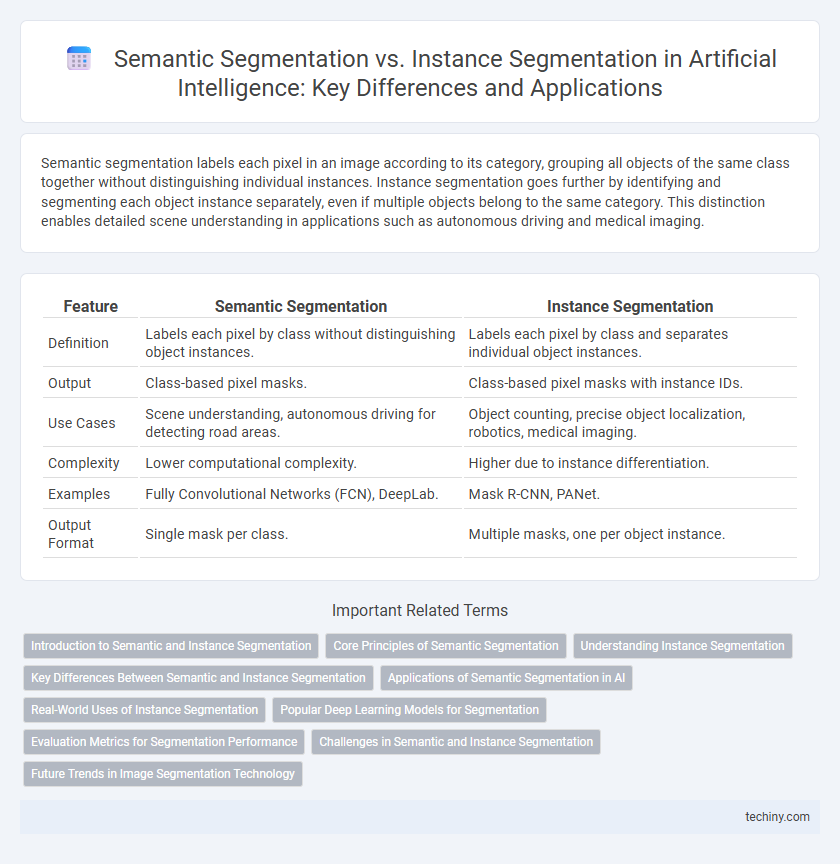Semantic segmentation labels each pixel in an image according to its category, grouping all objects of the same class together without distinguishing individual instances. Instance segmentation goes further by identifying and segmenting each object instance separately, even if multiple objects belong to the same category. This distinction enables detailed scene understanding in applications such as autonomous driving and medical imaging.
Table of Comparison
| Feature | Semantic Segmentation | Instance Segmentation |
|---|---|---|
| Definition | Labels each pixel by class without distinguishing object instances. | Labels each pixel by class and separates individual object instances. |
| Output | Class-based pixel masks. | Class-based pixel masks with instance IDs. |
| Use Cases | Scene understanding, autonomous driving for detecting road areas. | Object counting, precise object localization, robotics, medical imaging. |
| Complexity | Lower computational complexity. | Higher due to instance differentiation. |
| Examples | Fully Convolutional Networks (FCN), DeepLab. | Mask R-CNN, PANet. |
| Output Format | Single mask per class. | Multiple masks, one per object instance. |
Introduction to Semantic and Instance Segmentation
Semantic segmentation assigns a class label to each pixel in an image, enabling detailed understanding of object categories but not distinguishing between individual instances. Instance segmentation extends this approach by identifying and delineating each object instance separately, providing both class labels and unique object boundaries. These techniques are fundamental in applications such as autonomous driving, robotics, and medical imaging for precise scene interpretation and object recognition.
Core Principles of Semantic Segmentation
Semantic segmentation involves classifying each pixel in an image into predefined categories, enabling detailed understanding of scene components without distinguishing individual object instances. This approach relies on pixel-wise labeling and spatial coherence, ensuring that all pixels belonging to the same class share the same label. Core principles include accurate boundary delineation, context-aware feature extraction, and consistent classification across homogeneous regions.
Understanding Instance Segmentation
Instance segmentation goes beyond semantic segmentation by not only classifying each pixel into a category but also distinguishing between individual objects within the same class, enabling precise object-level identification. This technique combines object detection and semantic segmentation, leveraging convolutional neural networks (CNNs) and region proposal networks (RPNs) to produce accurate masks for each detected instance. Instance segmentation is essential in applications like autonomous driving and medical imaging, where understanding object boundaries and differentiating overlapping objects is critical for decision-making.
Key Differences Between Semantic and Instance Segmentation
Semantic segmentation classifies each pixel in an image into predefined categories, treating all objects of the same class as a single entity. Instance segmentation not only categorizes pixels but also distinguishes individual objects within the same category, providing unique labels for each instance. The key difference lies in instance segmentation's ability to separate and identify multiple objects of the same class, essential for object counting and precise localization.
Applications of Semantic Segmentation in AI
Semantic segmentation plays a crucial role in autonomous driving by enabling precise road and object labeling to improve navigation and safety systems. In medical imaging, it facilitates detailed tissue and organ identification for accurate diagnostics and treatment planning. Agricultural AI uses semantic segmentation to monitor crop health and optimize resource management through field mapping and plant classification.
Real-World Uses of Instance Segmentation
Instance segmentation enables precise object identification and differentiation in complex environments, essential for autonomous driving to detect and track individual vehicles and pedestrians. In healthcare, it supports accurate tumor boundary delineation for personalized treatment by isolating each lesion in medical imaging. Retail applications benefit from instance segmentation by automating inventory management and enabling detailed product recognition in crowded shelf scenarios.
Popular Deep Learning Models for Segmentation
Popular deep learning models for semantic segmentation include U-Net, DeepLabv3+, and Fully Convolutional Networks (FCNs), which focus on classifying each pixel into predefined categories. Instance segmentation models like Mask R-CNN and PANet extend this by identifying individual object instances within those classes, combining object detection with pixel-level mask prediction. These architectures leverage convolutional neural networks and feature pyramid networks to enhance accuracy in complex scenes with overlapping objects.
Evaluation Metrics for Segmentation Performance
Semantic segmentation evaluation primarily relies on metrics like Intersection over Union (IoU) and Pixel Accuracy, measuring how well predicted classes align with ground truth on a per-pixel basis. Instance segmentation assessment incorporates Average Precision (AP) at various IoU thresholds, capturing the detection and delineation quality of individual object instances. The combination of precision, recall, and mean Average Precision (mAP) metrics provides comprehensive insights into segmentation models' effectiveness for both semantic and instance-level tasks.
Challenges in Semantic and Instance Segmentation
Semantic segmentation struggles with accurately distinguishing adjacent objects of the same class, leading to merged boundaries and loss of instance-level details. Instance segmentation faces challenges in balancing precise object localization with class labeling, especially in crowded or overlapping scenes, which complicates mask generation. Both tasks require extensive annotated datasets and significant computational resources to achieve high accuracy in complex environments.
Future Trends in Image Segmentation Technology
Emerging trends in image segmentation technology emphasize increased accuracy through hybrid models that combine semantic segmentation's pixel-level classification with instance segmentation's object differentiation. Advances in deep learning architectures, such as transformer-based networks, are driving enhanced contextual understanding and real-time processing capabilities. Future developments target scalability and adaptability to diverse applications including autonomous driving, medical imaging, and augmented reality, promoting more precise and efficient scene interpretation.
Semantic Segmentation vs Instance Segmentation Infographic

 techiny.com
techiny.com